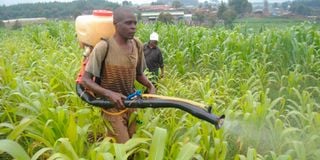Accurate fertiliser use in maize production

Ekuri Adamba sprays maize crops with NPK fertiliser in Elburgon, Nakuru County, in 2021. Many farmers are using foliar fertiliser to cut on labour costs.
What you need to know:
- Nitrogenous fertiliser should thus be used during topdressing.
- The quantities of nutrients applied to the crop depend on the requirements and soil fertility.
- Fertiliser application should be done at the right time when the crop requires nutrients.
Farmer Moses' maize crop is now about knee-high and the first weeding was done.
This week, the farmer was working on top-dressing as he followed the fertiliser programme we developed.
For fertiliser application, one should follow the 4Rs concept to enable the plants to utilise the nutrients efficiently.
The 4Rs stand for the right source, right rate, right time and the right fertiliser as required by the crop.
For the right source, one should match the fertiliser type with the needs of the crop.
For example, during planting, Farmer Moses used phosphorus fertiliser to enable root development.
Phosphorus does not easily leach, hence the placement method is the most suitable for the application.
Phosphorus is applied into each hole and thoroughly mixed to prevent scorching the maize seeds.
Fertiliser application should be done at the right time when the crop requires nutrients.
This decision should be based on the consideration of crop nutrient uptake, soil supply, nutrient-loss risks and field operation.
Nitrogen
For instance, the use of nitrogen during planting results in the loss of nutrients since the mineral is highly soluble in water, and easily leached beyond the plants' roots zone.
Nitrogenous fertiliser should thus be used during topdressing.
In Farmer Moses' case, he will top apply Calcium Ammonium Nitrate (CAN).
He will apply it at the rate of 25 grams per metre square. During the flowering and grain filling stages, Farmer Moses will apply potassium nitrate at the rate of 25 grams per meter square.
Urea can also be used in topdressing instead of CAN since it also provides nitrogen.
However, the majority of growers apply CAN since it has a lower volatilisation risk in dry soils and has a neutral effect on soil acidity.
The optimum timing of fertiliser application is determined by the nutrient uptake pattern of the crop.
Wrong timing of application results in nutrient loss, fertiliser wastage, and crop and environmental damage.
Farmers should consider splitting fertiliser applications to prevent salt damage to the crop and improve the plant's nutrient uptake rates.
The quantities of nutrients applied to the crop depend on the requirements and soil fertility.
In Farmer Moses' case, precise amounts will be applied since he conducted the soil test analysis. Applying excess fertiliser results in loss of nutrients as the plants cannot absorb all of it.
Nitrogenous fertiliser
Put the fertiliser in the right place. For instance, foliar fertiliser should be applied to the leaves and not to the soil.
Avoid putting too much nitrogenous fertiliser on the leaves, as this results in scorching effects.
The Fertigation method can be used in top dressing in cases where drip irrigation or centre pivot irrigation systems are being used in crop production.
However, one should ensure the fertiliser used is soluble in water. Side-dressing or banding methods can also be used in top-dressing as it enables the growers to provide a high nutrient concentration in the vicinity of the developing roots for efficient crop nutrient uptake.
Fertiliser application should be done when the soil is sufficiently wet, as this helps to immobilise the nutrients and prevent surface runoff.
Above is the fertiliser application programme that Farmer Moses will be using.
In our next article, we shall look at record-keeping in maize production.




